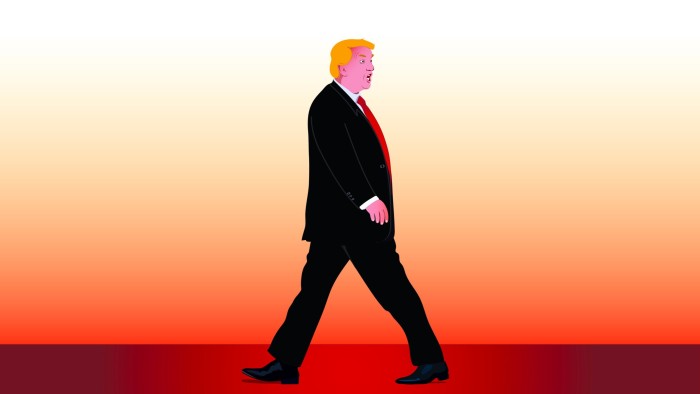Unlock the White House Watch newsletter for free
Your guide to what Trump’s second term means for Washington, business and the world
There are many reasons to feel confused by current American policy. US President Donald Trump keeps issuing “final” tariff threats — then backing down.
The White House wants to create industrial jobs — but is gutting the Inflation Reduction Act that was doing just that, mostly in red states. Scott Bessent, Treasury secretary, wants dollar dominance, but has presided over a 10 per cent fall in its value. And so on.
However, if you want to feel more baffled, look at markets. This month the one-year swaps market is pricing modest rate cuts from the Federal Reserve, which normally implies lower growth and inflation.
However, equity prices suggest an improving economy: American stock markets are at record highs and Wall Street analysts are projecting continued gains amid strong earnings forecasts. Moreover, so-called cyclical stocks (which benefit from growth) are significantly outperforming defensive ones, notes Torsten Sløk, chief economist at Apollo, the private capital group.
“This is not consistent,” Sløk adds. “Either the bond market is wrong, and rates must move higher due to accelerating growth. Or, equity markets are wrong, and stocks have to move lower because growth is slowing down.” Ouch.
Why? There are at least three possible explanations. One might be a “double Taco” trade (I am referring here to my colleague Robert Armstrong’s idea that “Trump always chickens out”). More specifically, equity prices might be pricing an assumption that tariff threats will be watered down, and bond markets pricing a belief Trump will not actually execute debt-expanding measures and cause investors to spurn Treasuries.
This is not crazy. Trump has repeatedly reneged on tariffs this year, along with threats to fire Jay Powell as chair of the Federal Reserve, and a so-called Section 899 clause that might have caused non-American investors to flee from Treasuries was recently removed from Trump’s “big, beautiful bill”, which passed into law last week. Hence that Taco tag.
But there is an alternative explanation that might be dubbed the “double genius” idea: investors believe that Trump will actually execute his plans, but they will be so brilliant that they deliver higher growth, lower prices and falling debt — all at once.
More specifically, figures such as Kevin Hassett, Trump’s economic adviser, insist that the BBB act will turbocharge growth, while inflation is lowered through deregulation and lower energy prices. And when the rating agency Moody’s cut the US credit rating because of its $37tn (and rising) debt, Bessent dismissed that as a “lagging indicator”, arguing that revenues will rise due to tariffs and growth.
In the meantime, he is rolling out tricks to ease the scheduled $9tn Treasury auctions in the next 12 months, such as reforms to encourage banks to buy more bonds and weighting issuance towards short-term, not long-term, bonds. (That is ironic since Bessent’s team lambasted his predecessor Janet Yellen for doing just that.)
And some investors accept this spin — or so it seems. No wonder: the Atlanta Fed’s real-time estimate of current GDP is 2.6 per cent, and there is little evidence that tariffs have caused major price increases — yet. And while institutions such as the World Bank have slashed their global growth forecasts, due to tariffs, the Oxford Economics group — to cite one private sector entity — thinks this week’s “new tariff rates . . . and the 50 per cent copper levy” creates “only modest downside risk”.
Indeed, it thinks these measures will “only” add 0.08 percentage points to core inflation next year, and reduce real GDP by a mere 0.1 per cent — and the latter will be offset by the BBB’s fiscal boost. Thus while “the mix of trade agreements and threatened tariffs will push the US effective tariff rate to almost 20 per cent on August 1” that is “less than our recession threshold”. Hence the market calm.
However, another, more cynical, way to explain the disjunction is that it is simply impossible to make credible — or consistent — forecasts now due to a lack of recent historical precedents for Trump, and pernicious time-lag effects. One problem is that US companies have amassed huge stockpiles to dodge tariffs. Another is that companies are “rearranging” China-linked supply chains, as a McKinsey report says — and while this is easy in some sectors (like T-shirts) it is hard in others (like laptops and fireworks).
Similarly, although the Dallas Fed just warned that immigration curbs could reduce growth by 0.75-1 percentage points this year, the timing of this is unclear. So is the impact of Trump’s proposed spending cuts (which mostly hit after the next midterm elections in 2026), and whether his wild policy flip-flops prompt companies to delay investment or else just adapt to this uncertainty (as they eventually did during the pandemic).
Maybe more clarity will emerge when American companies report on earnings next week. Or maybe either the bond or equity markets will adjust. Until then, however, they symbolise the confusion. Think of this when you next look at your portfolio.



